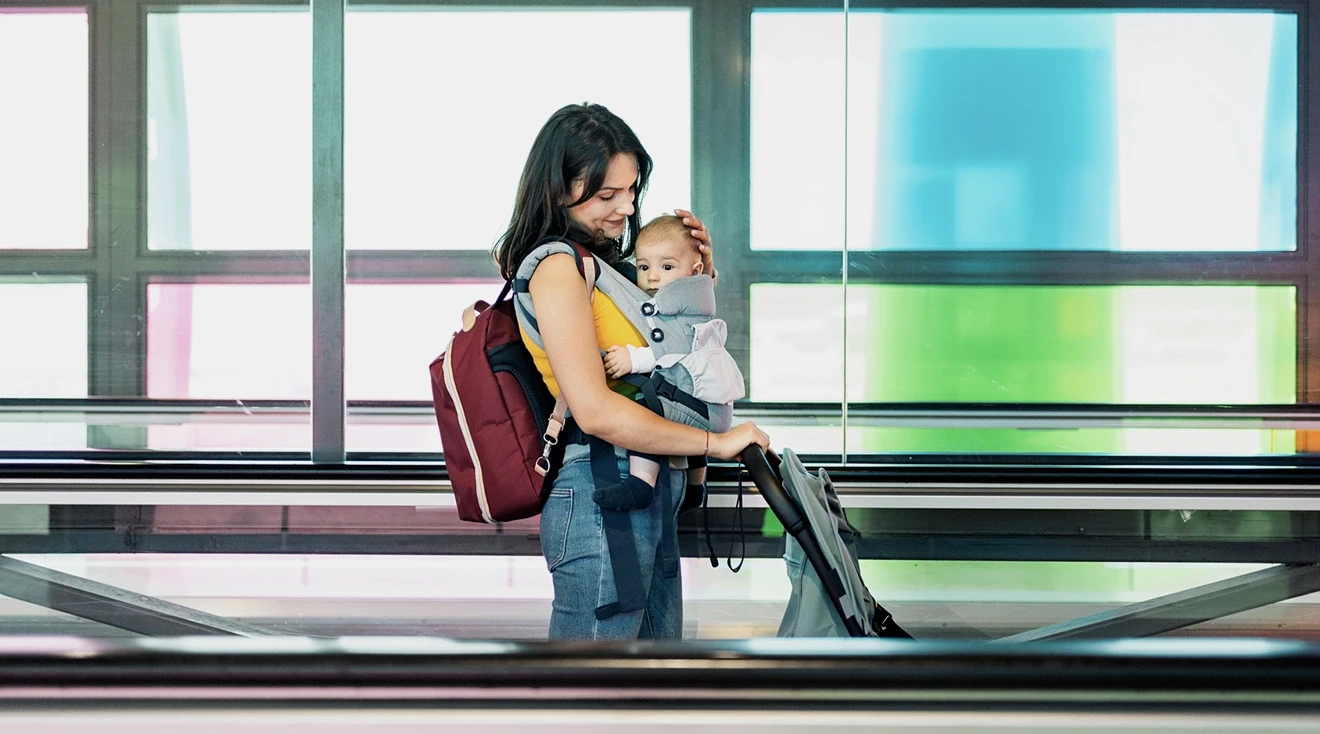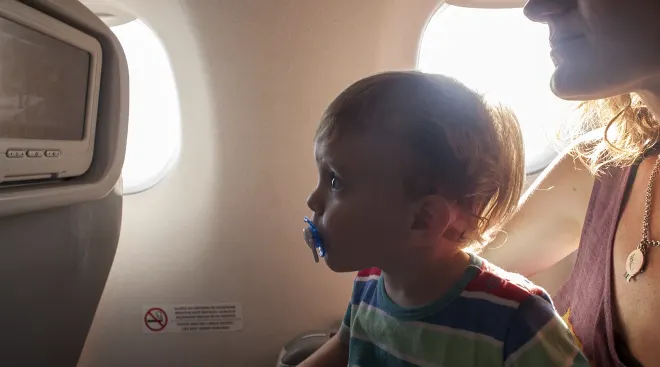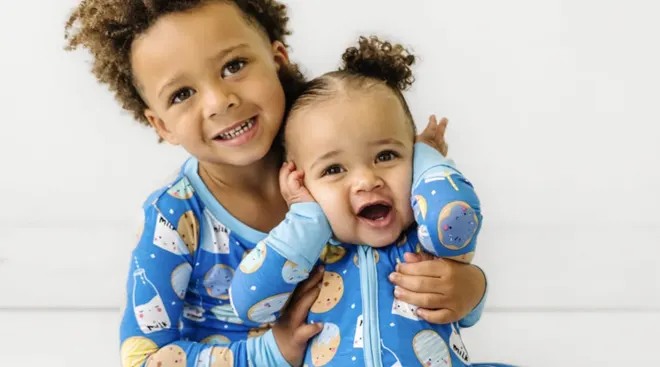30 Tips to Keep in Mind When Traveling With an Infant
Sure, going away is exciting—but when you’ve got little ones to account for, getting ready for a trip can feel more like work than vacation. Traveling with baby is intimidating, but it’s certainly not impossible. In fact, family travel expert Corinne McDermott believes traveling with an infant is often easier than traveling with an older toddler. “They’re not mobile, they’re not wiggling and they’re eating and sleeping around the clock,” she says. “It doesn’t really matter where you are!”
That said, whether you’re getting to your destination by plane, train or automobile, you’ll still want to prepare to ensure your journey goes as smoothly as possible. Below, experts break down all the travel-with-baby tips to know before you depart.
According to the American Academy of Pediatrics (AAP), both premature and full-term babies shouldn’t fly for the first few months of life unless it’s absolutely necessary. Flying can increase baby’s exposure to infectious diseases, so it may be best to wait until their immune system is a little more developed, or until they’ve received some of their initial immunizations, which are generally given at the 2 month visit, but can be given after 6 weeks old. Traveling by train poses the same risk. Road trips are usually the safest option for newborns and infants. Just make sure to have a properly installed infant car seat and take breaks every few hours, per the AAP. Of course, it’s always best to check in with your pediatrician before planning any kind of vacation with baby.
Traveling with an infant can seem like a daunting task, but there are several ways to make it go a bit smoother. Whether you’re hitting the road, taking a train or flying, consider the following travel-with-baby tips:
Stick to baby’s schedule
Odds are baby has a naptime, bedtime and feeding schedule they’re used to. Children tend to behave better when they have a predictable sense of order, so try to plan your travel—as well as events on the trip—around that schedule (i.e. after baby’s nap or meal) if you can, advises parenting coach Tammy Gold. They’ll likely be less cranky if they’re well-rested and fed.
Keep baby’s meals handy
On a similar note, while traveling with an infant, pack plenty of formula, bottles, water (for babies older than 6 months) and other solids. Pack more than you think you’ll need in case of delays—and don’t forget to take all the essentials you’ll need for pumping while traveling.
Bring extra clothes and lots of diapers
When traveling with an infant, you’ll want anything and everything that can help clean up a messy emergency. Pack extra wipes in your carry-on diaper bag, as well as multiple changes of clothes for baby. “Bring more diapers and wipes than you think you’ll need,” suggests McDermott. Accidents happen. Stash plastic bags to hold trash until you have the opportunity to dispose of it properly. While you’re at it, keep a change of clothes for yourself handy in case of spit up or a blowout. If baby makes a mess, you might take the brunt of it. Plus, don’t forget the essentials, like travel-sized diaper cream, baby shampoo, body wash, moisturizer and other staples in baby’s daily routine, suggests McDermott. (This checklist is a great tool for packing all the baby essentials you’ll need in your diaper bag.) Gold also suggests trying overnight diapers for long travel days to prevent baby from getting uncomfortably wet.
Bring baby-safe medication
Consider also packing a first-aid travel kit in case of unexpected incidents, like if baby has an allergic reaction on the plane. It can also come in handy once you’ve landed, since you won’t want to hunt for a pharmacy in a strange place at an odd hour. You’ll also want to bring nasal aspirators, nasal saline drops, and infant Tylenol in case baby gets sick while traveling. Check in with your pediatrician for their recommendations on what medications to pack. Plus do some research before leaving on local pediatricians and pediatric hospitals in case of emergencies.
Pack baby’s toys
Whether you’re traveling with an infant or a toddler, packing books and toys to keep them entertained is key. Bring a mix of baby’s favorites, including items that offer comfort, like their favorite stuffed animal or lovey. Having that small comfort from home when baby’s in a new place can go a long way to making them feel happy and safe, Gold says. Bringing new toys or options that baby doesn’t usually play with can be a game changer too. “New situations also offer new perspectives, so that book your child loves for hours at home may not be of interest to them at all on a flight. But that other one they’ve never picked up will suddenly occupy them for hours,” Lund says. “Books, wooden puzzles, busy-boards and coloring books are great for flights because they pack pretty easily and don’t require movement to be used.” Wondering if you should consolidate baby’s books onto one device to make your bag lighter? McDermott says to do this only as a last resort: “Once you pull that tech out, it’s hard to go back.”
Go over the logistics beforehand
If you’re flying with a baby internationally, do some research beforehand to see if there are any special passport or visa requirements, or immunizations baby will need. Also investigate if getting travel insurance is a good idea. Finally, call your lodgings beforehand to see what kind of travel gear they offer. This can help save you the effort of packing baby gear.
Arrive early
Whether you’re flying with baby or traveling by train, give yourself ample time. Get to the airport or train station a little earlier than you normally would to check in, request any assistance and board when you can. The last thing any parent traveling with little ones wants is the additional stress of missing their departure time.
Don’t worry about other passengers
When traveling with an infant, one of the primary anxieties parents have is disrupting other passengers. While it can be really hard, try not to worry about what others think. “No one wants to be the stereotypical ‘bad parent’ on a plane with a screaming kid, but there’s a reason it’s so prevalent,” says Tyler Lund, founder and lead contributor at Dad on the Run. “Parents need to do what they need to do and what’s best for their children, regardless of whether it interrupts another passenger’s enjoyment of their in-flight movie.” Instead of worrying about other passengers, spend your time and energy making baby comfortable.
Be patient with yourself and baby
Another important tip for traveling with baby? Show yourself grace. Even with extra time and tons of planning, it can be challenging—with or without a child in tow. Despite all of your planning, baby may have a fit, or things may not go as smoothly as you had hoped. Accept the situation at hand and roll with it, Lund says. “Even the most epic meltdown won’t ruin the rest of your vacation.” It’s also okay not to be as strict about rules as you might be at home to make things easier on yourself and your little one. Be patient with yourself and your kiddo and know you’re both doing the best you can.
Anxious about an upcoming flight? Check out the following tips for flying with baby to ensure you both have a stress-free and enjoyable time.
Figure out what time to fly
Chaos is inevitable around peak travel periods, like the holidays, spring break and the summer months, but you can avoid some of it by traveling early. Generally, airports are less crowded earlier in the morning, and early flights are less likely to have travel delays. “Given the choice between an early flight or mid-afternoon, I’ll take early every time,” McDermott says. “Some kids might actually go back to sleep for the ride to the airport.” As for booking the cheapest tickets, “steering clear of the weekends usually offers the best opportunity for reasonable airfare,” she adds.
Know TSA rules for breast milk and formula
Wondering what the deal is with packing formula or breast milk when flying with baby? According to TSA, when traveling with an infant, you can take breast milk, formula and baby food (like puree pouches) in quantities greater than 3.4 ounces for your carry-on; cooling accessories like freezer packs and gel packs are also allowed. These items are subject to additional screening though, so have them grouped together in a separate bag to make the check-in process go smoother. “It’s just easier to show security when you have all of baby’s food and drinks together,” McDermott says, adding that, while a clear bag may speed up the screening, it’s not necessary.
Gate check your stroller
Not to worry if you don’t have one of those cool micro travel strollers that folds up to fit in the overhead compartment. As you’re checking your luggage, tell the attendant at the counter that you’d like to gate check the stroller. They’ll give you a tag to attach to it, which is all the gate attendant needs to see as you’re boarding. The only stipulation: The stroller needs to be able to fold in half. With most airlines, it’ll be waiting for you on the ramp as you deplane.
Prepare baby for takeoff and landing
One of the most important tips for flying with baby? Be sure to soothe them during takeoff and landing. “Babies and toddlers tend to feel the most pain from the pressure, since the Eustachian tubes in their ears are much smaller,” explains McDermott. “The act of swallowing helps to clear them, so nursing or sucking on a bottle or pacifier can help. However, don’t be afraid to administer a dose of baby pain reliever if your child really seems to be in pain.” (Get the green light from your pediatrician first.) For older kids, swallowing snacks or drinks should help with the ear pain from the change in air pressure. Plus, while pain relievers may be okay, experts don’t recommend offering little ones medicines like Benadryl to help them “sleep better” on the flight, as it can cause adverse side effects.
Think carefully about your seats
One of the most valuable tips for flying with baby? If you have the flexibility, choose seats that work best for your family. Lund recommends the bulkhead seats toward the front. These are the rows without seats in front of them, and they often have more leg room. Some airlines may also have a pull-out bassinet in the bulkhead area too. Call your airline ahead of time and see if they’ll let you reserve the bulkhead seats, suggests Lund.
McDermott, on the other hand, prefers the back of the plane, where you can nab a spot closer to the bathroom and the service galley. “It’s easier to catch the flight attendant’s attention should you require assistance with anything,” she explains. A window seat is also usually better for baby to protect them from the service carts and any items that may fall out of overhead bins.
Consider getting baby their own seat
While the Federal Aviation Administration (FAA) allows babies and toddlers under 2 years old to sit on your lap, the AAP suggests getting baby their own seat with a car seat that’s certified for airplane use. Check in with your airline on whether baby’s gear will count as luggage and whether there are any rules and regulations to keep in mind.
Accept help from anyone you can
Many passengers or crew members will be willing to help a family traveling with an infant. Particularly at the airport, you might be surprised at how friendly and helpful TSA agents, airline employees and flight attendants can be when you ask for assistance.
Figure out if pre-boarding is right for your family
One of the biggest questions parents have when flying with baby: To preboard or not to preboard? It’s really a matter of preference and your child’s temperament. Is an extra 30 minutes of sitting on the plane a recipe for disaster—or is that additional time going to help everyone get settled? “Personally, if I let my kids run wild until the last minute, it takes them a long time to settle down,” McDermott says. “I prefer pre-boarding because it gives me the opportunity to get organized and settle the kids in their seats. You want to make sure you have access to a close overhead bin, as well as have time to install a car seat if you brought one.”
Find the airport’s play areas
Most major airports will have at least one play area for children—and this can be a great place for them to get all their energy out before boarding a flight. “It also helps to keep them from falling asleep in a stroller or on seats at the gate right before boarding,” Lund says. While it’s unavoidable at times, waking up little ones right before boarding a plane may quickly cause a meltdown.
Keep baby entertained mid-flight
“Most toddlers don’t like being restrained for lengths of time and just want to get up and explore the plane,” Lund says. Along with toys, keeping baby entertained may involve walking up and down the aisle with them when the seatbelt sign is off. Pay no mind to other passengers—as long as baby is safe and happy, that’s really all that matters.
Use bedtime as a tool for international flights
For international flights, consider overnight options, and book flights around baby’s normal bedtime. “[This] gives them a chance to calm down, get used to the setting and fall asleep. It also helps in the case of a minor delay,” Lund says. “Our boys refused to sleep on our first flight until two hours after their bedtime… Once they fell asleep though, they were out for the rest of the flight and gave us time to ourselves.”
Keeping your little one happy while they’re strapped into a car seat for hours can be a challenge. As you gear up for a road trip with baby, keep the following travel-with-baby tips in mind:
Check the car seat
Baby will be spending the entire ride in their car seat, so it’s crucial to make sure they’re safe and secure in a properly installed car seat. While babies shouldn’t sleep in car seats for long stretches of time or overnight, the AAP notes that babies can doze off in a properly installed car seat while your vehicle is in transit.
Plan your route
Know where the gas stations and rest stops are located. Moreover, take note of any hotels along the way in case you need one, and call ahead to see if they provide a safe sleep space for baby. If not, bring a bassinet or a travel crib. Also, don’t be super-strict about arrival time. “You can’t plan around unexpected diaper changes or needing to nurse,” McDermott says. “If you go with the expectation that things will take a lot longer than usual, you’ll be fine.”
Time your departure
If you’re going to be in the car for a few hours, try timing it with baby’s nap schedule or earlier in the morning when they’re still sleeping. For longer trips, consider driving at night during baby’s normal bedtime.
Make sure everything you need is handy
Before you pull out of the driveway, make sure you have everything you and baby will need within arm’s reach. This includes extra clothes, diapers, wipes, meals and toys for baby, as well as water, hand sanitizer, sunglasses and a phone for you.
Sit in the backseat with baby
If possible, it’s smart to have a caregiver sit in the back to help with baby’s needs throughout the ride. It’ll also help keep them entertained. Whether you’re reading board books or singing a song, interaction is key when traveling with baby. “When they’re small and rear-facing, it gets awfully boring in that back seat,” McDermott says. “An engaged, safe and comfortable baby is usually a happy baby.”
Take breaks every few hours
Not only will this help you stretch your legs, but it may also keep baby from getting too restless. The AAP recommends taking a break every two to three hours during day trips and four to six hours at night. Use this time to change baby’s diapers and feed them. (The AAP also cautions parents to never breastfeed baby in a moving car.)
Pull over when you need to
Maybe baby just won’t stop crying because they threw their toy and now it’s stuck somewhere between the seat and the door, or maybe you need to use the restroom. Whatever the reason, if there’s anything distracting you from the road, pull over and take the time to deal with it. If you’re traveling with baby alone and need to leave the car, take them with you. Otherwise, work with your traveling companions to ensure everyone’s needs are met before getting back on the road.
The train seems ideal for traveling with baby, right? You’re free to move around, baby always has a view and you don’t have to keep your eyes on the road. “For older toddlers, you can’t beat it,” McDermott says. Plus, Amtrak also offers great discounts for kids: Infants 0 to 2 travel for free, and children ages 2 to 12 ride at half price. However, there are some things to keep in mind to have a smooth ride—and many of these will be similar to our tips for flying with baby.
Tag team finding seats
If you’re traveling with your partner or someone else, have them scout out seats while you tend to baby. Many cars have four seats facing each other toward one end, and these typically have more room. Try to snag those seats if they’re available. Also, ask the conductor which doors will open at your stop so you won’t have to scramble to switch cars.
Sit by a window
If you’re able, try to grab baby a window seat. Similar to flights, it’s safer than the aisle. Plus, the view outside may keep baby engaged and entertained while you take a few minutes to yourself.
Above all else, when traveling with baby, remember to have patience. “Tantrums and breakdowns aren’t malicious; they’re a sign of frustration,” Lund says. “Remembering this might be the difference between a bad [experience] that’s a side note to an otherwise great vacation, and a bad [experience] causing a bad vacation.”
Please note: The Bump and the materials and information it contains are not intended to, and do not constitute, medical or other health advice or diagnosis and should not be used as such. You should always consult with a qualified physician or health professional about your specific circumstances.
Tammy Gold, LCSW, MSW, CEC, is a licensed therapist, certified parent coach, author and the founder of the Tammy Gold Nanny Agency. She has over 20 years of experience and received her bachelor’s degree from the University of Pennsylvania and her master’s degree from Columbia University.
Corinne McDermott is a TICO-certified family travel expert with over 15 years of experience and the founder of the blog Have Baby Will Travel. She received her bachelor’s degree from Toronto Metropolitan University.
Tyler Lund is the founder and lead contributor to Dad on the Run, a blog dedicated to fatherhood. He’s also a software development manager, tech nerd, home-brewer, three-time marathoner and rescue dog owner. He loves traveling to new and unique places a bit off the beaten path and sharing stories from these adventures.
HealthyChildren.org, Flying with Baby: Parent FAQs, November 2019
HealthyChildren.org, Is it Safe for My Baby to Travel in a Car Seat a Few Hours at a Time?, December 2022
Head Start Early Childhood Learning & Knowledge Center, The Importance of Schedules and Routines, September 2023
Cleveland Clinic, Why Can’t Babies Drink Water?, September 2023
Transportation Security Administration, Traveling With Children
Pediatrics Child Health, Air Travel and Children, January 2007
Federal Aviation Administration, Flying With Children, September 2023
HealthyChildren.org, Travel Safety Tips, August 2018
Amtrak, Discount Information for Children
Learn how we ensure the accuracy of our content through our editorial and medical review process.
Navigate forward to interact with the calendar and select a date. Press the question mark key to get the keyboard shortcuts for changing dates.





















































